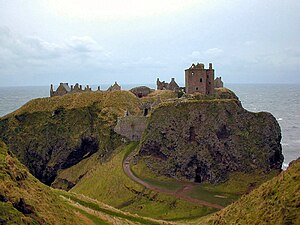
Back إسكتلندا في العصور الوسطى العليا Arabic Escocia en la Alta Edad Media Spanish اسکاتلند در قرون وسطی میانه Persian Écosse au Moyen Âge central French Scozia nell'Alto Medioevo Italian Skottland i høgmellomalderen NN Skottland i høymiddelalderen NB Шотландия в Высоком Средневековье Russian 中世纪盛期的苏格兰 Chinese

| History of Scotland |
|---|
 |
|
|
The High Middle Ages of Scotland encompass Scotland in the era between the death of Domnall II in 900 AD and the death of King Alexander III in 1286, which was an indirect cause of the Wars of Scottish Independence.
At the close of the ninth century, various competing kingdoms occupied the territory of modern Scotland. Scandinavian influence was dominant in the northern and western islands, Brythonic culture in the southwest, the Anglo-Saxon or English Kingdom of Northumbria in the southeast and the Pictish and Gaelic Kingdom of Alba in the east, north of the River Forth. By the tenth and eleventh centuries, northern Great Britain was increasingly dominated by Gaelic culture, and by the Gaelic regal lordship of Alba, known in Latin as either Albania or Scotia, and in English as "Scotland". From its base in the east, this kingdom acquired control of the lands lying to the south and ultimately the west and much of the north. It had a flourishing culture, comprising part of the larger Gaelic-speaking world and an economy dominated by agriculture and trade.
After the twelfth-century reign of King David I, the Scottish monarchs are better described as Scoto-Norman than Gaelic, preferring French culture to native Scottish culture. A consequence was the spread of French institutions and social values including Canon law. The first towns, called burghs, appeared in the same era, and as they spread, so did the Middle English language. These developments were offset by the acquisition of the Norse-Gaelic west and the Gaelicisation of many of the noble families of French and Anglo-French origin. National cohesion was fostered with the creation of various unique religious and cultural practices. By the end of the period, Scotland experienced a "Gaelic revival", which created an integrated Scottish national identity. By 1286, these economic, institutional, cultural, religious and legal developments had brought Scotland closer to its neighbours in England and the Continent, although outsiders continued to view Scotland as a provincial, even savage place. By this date, the Kingdom of Scotland had political boundaries that closely resembled those of the modern nation.
© MMXXIII Rich X Search. We shall prevail. All rights reserved. Rich X Search